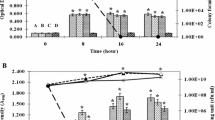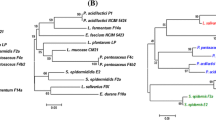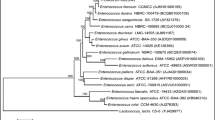Abstract
Gut microbiota remains a prominent source for a diverse range of potential probiotics. In this context, the current study explored the rectal region of experimental Wistar rat for the isolation of potent probiotic. Sixteen lactic acid bacteria (LAB), from rectal swab of Wistar rats, were subjected to evaluation of probiotic properties. Among all, AG5 was found unique with consistent probiotic properties and was further identified as Enterococcus faecalis AG5 (NCBI accession number KT248537) using 16S rDNA sequencing, followed by BLAST analysis. Since the Enterococci strains inhibit various food-borne pathogens efficiently while proving itself as a safe probiotic candidate, the study further evaluated the safety of the strain AG5 using primer specific PCR amplification which revealed the existence of gene encoding gelE, asa1, efaA, ace, vanA, and vanB and negative for cylA, hyl, and esp respectively. SEM analysis confirmed the adherence ability of AG5 to HCT 116 cells. Adherence was found to be non-colonial and scattered manner. Furthermore, the strain demonstrated a significant survivability during simulated gastrointestinal transit. Taken together, the E. faecalis AG5 was found potential probiotic candidate with future implication in both food and health industry.






Similar content being viewed by others

References
Daliri EB-M, Lee BH (2015) New perspectives on probiotics in health and disease. Food Sci Hum Wellness 4(2):56–65. https://doi.org/10.1016/j.fshw.2015.06.002
Sornplang P, Piyadeatsoontorn S (2016) Probiotic isolates from unconventional sources: a review. J Anim Sci Technol 58(1):26–37. https://doi.org/10.1186/s40781-016-0108-2
Ramos CL, Thorsen L, Schwan RF, Jespersen L (2013) Strain-specific probiotics properties of Lactobacillus fermentum, Lactobacillus plantarum and Lactobacillus brevis isolates from Brazilian food products. Food Microbiol 36(1):22–29. https://doi.org/10.1016/j.fm.2013.03.010
O’Bryan CA, Pak D, Crandall PG, Lee SO, Ricke SC (2013) The role of prebiotics and probiotics in human health. J Prob Health 01:1–8
Cebrián R, Baños A, Valdivia E et al (2012) Characterization of functional, safety, and probiotic properties of Enterococcus faecalis UGRA10, a new AS-48-producer strain. Food Microbiol 30:59–67
Martín-Platero AM, Valdivia E, Maqueda M, Martínez-Bueno M (2009) Characterization and safety evaluation of enterococci isolated from Spanish goats’ milk cheeses. Int J Food Microbiol 132(1):24–32. https://doi.org/10.1016/j.ijfoodmicro.2009.03.010
Sarantinopoulos P, Leroy F, Leontopoulou E et al (2002) Bacteriocin production by Enterococcus faecium FAIR-E 198 in view of its application as adjunct starter in Greek Feta cheese making. Int J Food Microbiol 72:125–136
Lozano C, González-Barrio D, García JT et al (2015) Detection of vancomycin-resistant Enterococcus faecalis ST6-vanB2 and E. faecium ST915-vanA in faecal samples of wild Rattus rattus in Spain. Vet Microbiol 177:168–174
Nueno-Palop C, Narbad A (2011) Probiotic assessment of Enterococcus faecalis CP58 isolated from human gut. Int J Food Microbiol 145(2-3):390–394. https://doi.org/10.1016/j.ijfoodmicro.2010.12.029
Grande Burgos MJ, Pulido RP, Del Carmen López Aguayo M et al (2014) The cyclic antibacterial peptide enterocin AS-48: isolation, mode of action and possible food applications. Int J Mol Sci 15:22706–22727
Thera M (2016) SymbioPharm : healing with bacteria since 1954. 1–4
Kitz R, Martens U, Zieseniß E et al (2012) Probiotic E.faecalis—adjuvant therapy in children with recurrent rhinosinusitis. Open Med 7:362–365
Morelli L, Capurso L (2012) FAO/WHO guidelines on probiotics. J Clin Gastroenterol 46:S1–S2. https://doi.org/10.1097/MCG.0b013e318269fdd5
Foulquié Moreno MR, Sarantinopoulos P, Tsakalidou E, De Vuyst L (2006) The role and application of enterococci in food and health. Int J Food Microbiol 106(1):1–24. https://doi.org/10.1016/j.ijfoodmicro.2005.06.026
Franz CMAP, Van Belkum MJ, Holzapfel WH, Abriouel H, Gálvez A (2007) Diversity of enterococcal bacteriocins and their grouping in a new classification scheme. FEMS Microbiol Rev 31(3):293–310. https://doi.org/10.1111/j.1574-6976.2007.00064.x
Sieladie DV, Zambou NF, Kaktcham PM et al (2011) Probiotic properties of lactobacilli strains isolated from raw cow milk in the western highlands of Cameroon. Innov Rom Food Biotechnol 9:12–28
Ghosh A, Sukumar G (2010) Study of the probiotic potential of lactic acid bacteria isolated from a variety of Indian fermented food. J Pharm Res 3:2254–2257
Kumar A, Kumar D (2015) Characterization of Lactobacillus isolated from dairy samples for probiotic properties. Anaerobe 33:117–123. https://doi.org/10.1016/j.anaerobe.2015.03.004
Kiehlbauch JA, Hannett GE, Salfinger M, Archinal W, Monserrat C, Carlyn C (2000) Use of the national committee for clinical laboratory standards guidelines for disk diffusion susceptibility testing in New York state laboratories. J Clin Microbiol 38(9):3341–3348
Barry AL, Craig WA, Nadler H, et al (1999) Methods for determining bactericidal activity of antimicrobial agents; approved guideline. Natl Comm Clin Lab Stand 19
Charteris WP, Kelly PM, Morelli L, Collins JK (1998) Antibiotic susceptibility of potentially probiotic Lactobacillus species. J Food Prot 61(12):1636–1643. https://doi.org/10.4315/0362-028X-61.12.1636
CLSI (2015) M02-A12; performance standards for antimicrobial disk susceptibility tests; approved standard—twelfth edition. Clin Lab Stand Inst Webb, H. E., Granier, S. A., Mrult, M., Millemann,
A.O. A.C. (1990) Official methods of analysis. doi:https://doi.org/10.1520/G0154-12A
Subramanian MR, Talluri S, Christopher LP (2015) Production of lactic acid using a new homofermentative Enterococcus faecalis isolate. Microb Biotechnol 8:221–229
Karasová P, Spiwok V, Malá S et al (2002) Beta-galactosidase activity in psychrotrophic microorganisms and their potential use in food industry. Czech J Food Sci 20:43–47
Green M, Sambrook J (2012) Molecular cloning
Dubey V, Ghosh AR, Bishayee K, Khuda-Bukhsh AR (2016) Appraisal of the anti-cancer potential of probiotic Pediococcus pentosaceus GS4 against colon cancer: in vitro and in vivo approaches. J Funct Foods 23:66–79. https://doi.org/10.1016/j.jff.2016.02.032
Mathara JM, Schillinger U, Guigas C et al (2008) Functional characteristics of Lactobacillus spp. from traditional Maasai fermented milk products in Kenya. Int J Food Microbiol 126:57–64
Succi M, Tremonte P, Reale A et al (2005) Bile salt and acid tolerance of Lactobacillus rhamnosus strains isolated from Parmigiano Reggiano cheese. FEMS Microbiol Lett 244:129–137
Bezkorovainy A (2001) Probiotics: determinants of survival and growth in the gut. Am J Clin Nutr 73
Hassanzadazar H, Ehsani A, Mardani K, Hesari J (2012) Investigation of antibacterial , acid and bile tolerance properties of lactobacilli isolated from Koozeh cheese. Vet Res Forum 3:181–185
Begley M, Gahan CGM, Hill C (2005) The interaction between bacteria and bile. FEMS Microbiol Rev 29(4):625–651. https://doi.org/10.1016/j.femsre.2004.09.003
de Vrese M, Stegelmann A, Richter B et al (2001) Probiotics—compensation for lactase insufficiency. Am J Clin Nutr 73(2 Suppl):421S–429S
Gomes BC, Esteves CT, Palazzo ICV, Darini ALC, Felis GE, Sechi LA, Franco BDGM, de Martinis ECP (2008) Prevalence and characterization of Enterococcus spp. isolated from Brazilian foods. Food Microbiol 25(5):668–675. https://doi.org/10.1016/j.fm.2008.03.008
Sivieri K, Spinardi-Barbisan ALT, Barbisan LF, Bedani R, Pauly ND, Carlos IZ, Benzatti F, Vendramini RC, Rossi EA (2008) Probiotic Enterococcus faecium CRL 183 inhibit chemically induced colon cancer in male wistar rats. Eur Food Res Technol 228(2):231–237. https://doi.org/10.1007/s00217-008-0927-6
Gu RX, Yang ZQ, Li ZH, Chen SL, Luo ZL (2008) Probiotic properties of lactic acid bacteria isolated from stool samples of longevous people in regions of Hotan, Xinjiang and Bama, Guangxi, China. Anaerobe 14(6):313–317. https://doi.org/10.1016/j.anaerobe.2008.06.001
Gilliland SE (1979) Beneficial interrelationships between certain microorganisms and humans: candidate microorganisms for uses as dietary adjuncts. J Food Prot 42(2):164–167. https://doi.org/10.4315/0362-028X-42.2.164
Patel HM, Pandiella SS, Wang RH, Webb C (2004) Influence of malt, wheat, and barley extracts on the bile tolerance of selected strains of lactobacilli. Food Microbiol 21(1):83–89. https://doi.org/10.1016/S0740-0020(03)00016-9
Creti R, Imperi M, Bertuccini L et al (2004) Survey for virulence determinants among Enterococcus faecalis isolated from different sources. J Med Microbiol 53:13–20
Pillar CM, Gilmore MS (2004) Enterococcal virulence—pathogenicity island of E. Faecalis. Front Biosci 9(1-3):2335–2346. https://doi.org/10.2741/1400
Charteris WP, Kelly PM, Morelli L, Collins JK (1998) Development and application of an in vitro methodology to determine the transit tolerance of potentially probiotic Lactobacillus and Bifidobacterium species in the upper human gastrointestinal tract. J Appl Microbiol 84(5):759–768. https://doi.org/10.1046/j.1365-2672.1998.00407.x
Juntunen M, Kirjavainen PV, Ouwehand AC et al (2001) Adherence of probiotic bacteria to human intestinal mucus in healthy infants and during rotavirus infection. Clin Diagn Lab Immunol 8:293–296
Bednarska NG, Schymkowitz J, Rousseau F, Van Eldere J (2013) Protein aggregation in bacteria: the thin boundary between functionality and toxicity. Microbiology 159(Pt_9):1795–1806. https://doi.org/10.1099/mic.0.069575-0
Franz CMAP, Stiles ME, Schleifer KH, Holzapfel WH (2003) Enterococci in foods—a conundrum for food safety. Int J Food Microbiol 88(2-3):105–122. https://doi.org/10.1016/S0168-1605(03)00174-0
Acknowledgments
The authors would like to acknowledge Prof. Anu Baisel, Senior Assistant Professor, Department of English, School of Social Sciences and Languages, VIT University for English and grammar correction.
Funding
We would like to express gratitude to VIT University, Vellore, for financial support (RGEMS-2016).
Author information
Authors and Affiliations
Corresponding author
Ethics declarations
Conflict of Interest
The authors declare that they have no conflict of interest.
Rights and permissions
About this article
Cite this article
Mishra, A.K., Ghosh, A.R. Characterization of Functional, Safety, and Probiotic Properties of Enterococcus faecalis AG5 Isolated From Wistar Rat, Demonstrating Adherence to HCT 116 Cells and Gastrointestinal Survivability. Probiotics & Antimicro. Prot. 10, 435–445 (2018). https://doi.org/10.1007/s12602-018-9387-x
Published:
Issue Date:
DOI: https://doi.org/10.1007/s12602-018-9387-x



